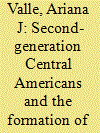| Srl | Item |
| 1 |
ID:
171066


|
|
|
|
|
| Summary/Abstract |
Whether Latinos in the United States are an ethnic or racial group is extensively debated. Some propose Latinos are an ethnic group on their way to becoming white, others contend Latinos are a racialised group, and an alternate perspective posits Latinos are an ethnoracial group. This study intervenes in this debate by examining the identities of second- and 1.5-generation Central Americans in Los Angeles, California. Drawing on 27 in-depth interviews, I show Central Americans have an identity repertoire, which includes national origin, panethnic, racial, and minority identities. I also capture the situations and reference groups that influence the deployment of ethnic and racial identities. These results suggest Central Americans develop an ethnoracial identity. I argue Central Americans’ ethnoracial identity emerges from agency – subjective understandings of themselves and resisting invisibility in Mexican Los Angeles – and from structure – a racialised society, institutionally-created panethnic categories, and racially-based experiences.
|
|
|
|
|
|
|
|
|
|
|
|
|
|
|
|
| 2 |
ID:
131960


|
|
|
|
|
| Publication |
2014.
|
| Summary/Abstract |
This article looks at the changing frameworks for the institutional and cultural incorporation of second-generation rural migrants in Shanghai. Beginning in 2008, Shanghai launched a new policy of accepting migrant children into urban public schools at primary and secondary levels. I show that the hukou (household registration) is still a critical social boundary in educational institutions, shaping uneven distribution of educational resources and opportunities, as well as hierarchical recognition of differences between urbanites and migrants. I have coined the term "segmented incorporation" to characterize a new receiving context, in which systematic exclusion has given way to more subtle forms of institutional segmentation which reproduces cultural prejudice and reinforces group boundaries.
|
|
|
|
|
|
|
|
|
|
|
|
|
|
|
|
| 3 |
ID:
101629


|
|
|
|
|
| Publication |
2010.
|
| Summary/Abstract |
Although Korea and Japan have had to confront rapidly declining working-age population projections, both countries kept their borders closed to unskilled workers from the mid-1980s to the early 2000s, and met labour demands through de facto guest worker programs and preferential policies for co-ethnic immigrants. However, by the mid-2000s, government officials could no longer turn a blind eye to the swelling ranks of immigrants within their borders and announced two contrasting proposals for immigrant incorporation: centralized rights-based legislation that targets specific immigrant groups in Korea and decentralized guidelines that prioritize community-based partnerships in Japan. Instead of resulting from deliberate decision making by either state to manage the permanent settlement of immigrants, I argue that these divergent approaches reflect grassroots movements that drew on existing strategies previously applied to incorporate historically marginalized groups in each society prior to the establishment of official incorporation programs. Migrant workers in Korea made significant inroads in gaining rights largely because of the strong tradition of labour and civil society activism in Korea's democratization movement. In Japan, grassroots movements led by generations of zainichi Koreans from the 1960s set the foundation for decentralized, community-based strategies for incorporating new immigrants from the late 1980s. Comparing two seemingly similar countries in East Asia, this article identifies patterns of interaction between new immigration and existing practices that have shaped relationships between dominant and minority communities and between state and non-state actors.
|
|
|
|
|
|
|
|
|
|
|
|
|
|
|
|